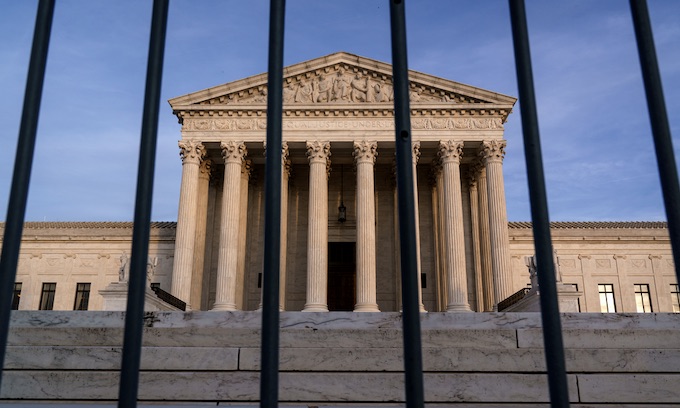The U.S. Supreme Court on Monday released a decision after unanimously ruling in favor of a man who had been sentenced to prison under the Armed Career Criminal Act.
The Supreme Court decision helps define what constitutes a singular criminal episode for the purposes of sentencing enhancements under the Armed Career Criminal Act.
Under federal law, an offender with three or more prior violent felony convictions occurring on separate occasions receives a mandatory minimum sentence of 15 years in prison if they are then convicted of illegal gun possession.
William Dale Wooden petitioned the Supreme Court last year to hear his case after he faced an enhanced sentence under the law because of crimes committed on just one night at one storage facility.
Wooden and three others were arrested and convicted of burglarizing 10 units in a storage facility in Dalton, Ga., in 1997, Justice Elena Kagan wrote in the opinion for the majority.
He was charged with 10 counts of burglary for each of the storage units and pleaded guilty to all charges. He was later released from prison and arrested again in 2014 when a police officer knocked on his door and asked to speak to his wife.
“The officer asked if he could step inside, to stay warm. Wooden agreed. But his good deed did not go unpunished,” Justice Kagan wrote. “Once admitted to the house, the officer spotted several guns. Knowing that Wooden was a felon, the officer placed him under arrest.”
Wooden was convicted on a charge of being a felon in possession of a firearm and was sentenced to nearly 16 years in prison after the court treated his previous burglary conviction as 10 separate criminal occasions.
Sentencing for a charge of being a felon in possession of a firearm would normally carry a maximum sentence of 10 years in prison, rather than the minimum sentence of 15 years in prison under the Armed Career Criminal Act.
The Supreme Court agreed with Wooden that his burglaries happened during the same criminal episode” and “at the same business location, under the same roof” and were charged in a single indictment.
Justice Kagan noted that the Sixth Circuit Court of Appeals had affirmed a lower court’s sentence for Wooden on the reasoning that burglaries of individual units occurred in a consecutive order.
“Consider first how an ordinary person (a reporter; a police officer; yes, even a lawyer) might describe Wooden’s ten burglaries — and how she would not,” Justice Kagan wrote in the opinion.
“The observer might say: ‘On one occasion, Wooden burglarized ten units in a storage facility.’ By contrast, she would never say: ‘On ten occasions, Wooden burglarized a unit in the facility.'”
Justice Kagan noted that even the Justice Department has concluded that it is “physically impossible” for an offender to enter different structures simultaneously.
“Wooden committed his burglaries on a single night, in a single uninterrupted course of conduct. The crimes all took place at one location, a one-building storage facility with one address. Each offense was essentially identical, and all were intertwined with the others,” Justice Kagan wrote.
“The burglaries were part and parcel of the same scheme, actuated by the same motive, and accomplished by the same means. Indeed, each burglary in some sense facilitated the next, as Wooden moved from unit to unit to unit, all in a row.”
Concurring opinions were also written by justices Sonia Sotomayor, Brett Kavanaugh, Amy Coney Barrett and Neil Gorsuch in which they expressed slight variances in the role of the court in such cases and the ambiguity of the law.
“The problem is that beyond easy cases like those lies a universe of hard ones, where a long list of non-exhaustive, only sometimes relevant, and often incommensurable factors promises to perpetuate confusion in the lower courts and conflicting results for those whose liberties hang in the balance,” Gorsuch wrote in his opinion.
“Imagine a defendant who sells drugs to the same undercover police officer twice at the same street corner one hour apart. Do the sales take place on the same occasion or different ones?”
Copyright 2022 United Press International, Inc. (UPI). Any reproduction, republication, redistribution and/or modification of any UPI content is expressly prohibited without UPI’s prior written consent.
—-
This content is published through a licensing agreement with Acquire Media using its NewsEdge technology.



















So, if you are a criminal, you just need to plan your crimes in a more organized fashion—combine multiple offenses so that they appear as one.
It’s all in how you do it.
Sounds like what they said. And In this case, i think the COPS GOT schanked over by this ruling, as HE KNOWINGLY Still bought firearms WHILE A FELON…
So according to Kagan ( I read somewhere that see was never an actual attorney, don’t know if it’s true) if this man broke into 10 different Condos or apartments at the same address. That would be one offense. Sorry not in my world. Ten different HOMES Ten victims! Why is it that the victims are always the losers in our Justice system.
The push to end Stand your ground is a prime example.
I wonder, how many ARE ACTUAL Attorneys’…